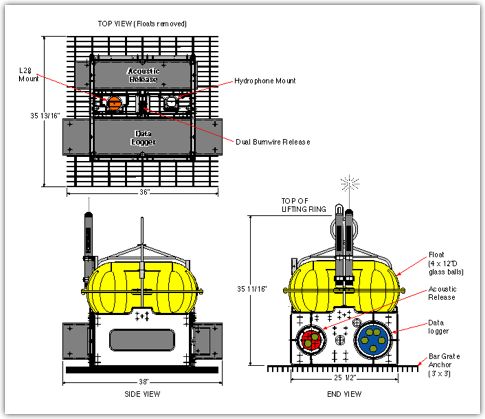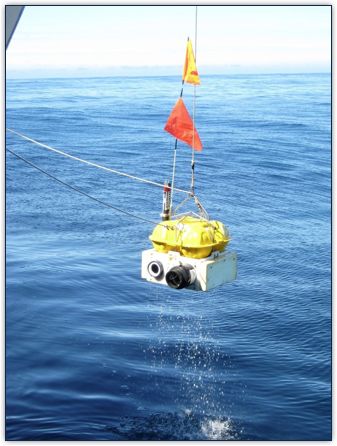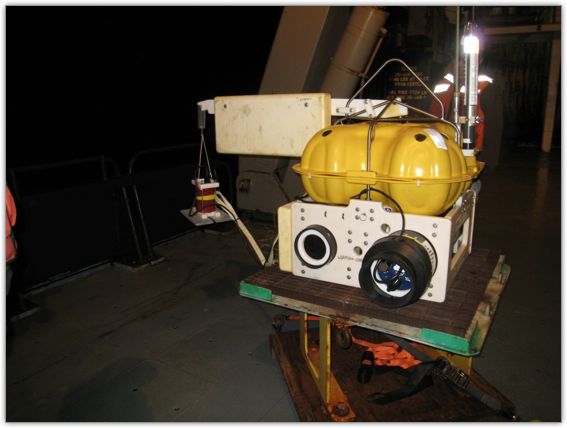
|

|
 |
 |

Appendix A4: MGL0910 SIO OBS Configurations and Performance Summary
|
 |
 |
 |
 |
 | For the ETOMO experiment, the Scripps Institution of Oceanography (SIO) OBSIP IIC provided 41 short-period ocean-bottom seismometers (OBSs). In addition, 4 experimental deployments were conducted to test a new sensor type and deployment configuration. The SIO team at sea included Ernie Aaron, Mark Gibaud and Phil Thai.
|
 |
 |
 |
 |
 |
 | The Institute of Geophysics and Planetary Physics at Scripps Institution of Oceanography (IGPP/SIO) in conjunction with the Ocean Bottom Seismology Instrument Pool (OBSIP) provided 41 of the 64 total instruments for the ETOMO study. The sensors used on the SP-OBS are an Sercel L28 gimbaled 3-component geophone, and a hydrophone. Each instrument is comprised of a 100-pound anchor, a four-ball McLane glass float assembly on which the lifting bail is attached, two syntactic foam blocks are added for additional floatation to aid positive buoyancy, and a polyethylene frame holding the sensors, an acoustic release transponder, an LC4x4 data logger, and a mechanical release system.
The SP-OBS float and frame components are stored separately in a custom rack system and are assembled and tested prior to deployment on a raised preparation platform, which is secured to the deck. The complete instrument weighs approximately 300 pounds in air. The anchor is a 100-pound iron grate held to the base of the poly frame by a single 2“ oval quick-link when the release mechanism is cocked and secured. When the anchor is released for recovery, the four 12” glass spherical floats, as well as the syntactic foam blocks provide sufficient buoyancy to lift the instrument at about 45 m/min to the sea surface. To increase visibility at the surface, an orange flag on a 48“ fiberglass-resin staff is attached to the floats. The recovery aids also include a Novatech low-pressure activated strobe beacon and radio, which operates at 160.725 MHz.
The acoustic release transponder developed in conjunction with ORE/EdgeTech is comprised of a main circuit board, a SIO developed alkaline battery pack, and an ITC-3013 transducer manufactured by International Transducer Corp. These are all installed in and on a 4-5/8” aluminum pressure case. All SIO transponders interrogate at 11 kHz and respond at 13 kHz. The alkaline batteries provide 18 volts power for the burn cycle, 12 volts power for the transponder, and 9 volts power for the circuit board logic. The release mechanism includes two double wire burn elements. The acoustic battery pack provides up to 18 volts to one of two release wires. Release of the anchor typically occurs within 6-7 minutes.
|
 |
 |
 |
 |
 |
 | SIO SEGY files contain one channel per file. For each OBS there are four SEGY files. The naming of the SEGY files and and numbering of the data channels is as follows (where ## is the OBS Number):
OBS##_L28X/Y_etomo.segy Channels 0 & 1 = horizontals
OBS##_L28Z_etomo.segy Channel 2 = vertical
OBS##_HYD_etomo.segy Channel 3 = hydrophone
* For the experimental sites A and B replace 'L28' with 'Tril' and 'HYD' with 'DPG'
** Note: This is different from the numbering system used in the WHOI SEGY headers. The WHOI channel numbering convention is the one we are currently using in Upicker.
Note: Emilie Hooft felt that there was a problem with the ranges inserted in the SIO SEGY headers. Distances in the EW direction appeared to be too large. Distances in the NS direction appeared to be too small. She could not determine the source of this error in a quick look at the code used.
|
 |
 |
 |
 |
 |
 | During MGL0910 a total 45 OBSs were deployed at 41 sites. All 45 OBSs were successfully recovered. Deployments and recoveries went extremely smoothly; the SIO group is clearly experienced and competent. An assessment of the data quality is given in in the section "OBS Operations and Data Quality".
Performance TABLE? Clock corrections?
|
 |
 |
 |
 |
 |
 | Several experimental configurations of the SIO OBS were tested during MGL0910. The significant modifications included (i) a new type of sensor (Geospace Technologies GS-1) in order to compare its response to the Sercel L28 and (ii) the deployment of both the Geospace Technologies GS-1 and Sercel L28 sensors in an internal and external configuration (i.e., coupled to the main frame and deployed separately on the seafloor.
Three experimental configurations were deployed at Site 15, a sedimented site. One experimental configuration was deployed at Site 46, a hard rock site.
Summary of SIO Experimental Configurations
|
Site |
Sensor |
Configuration |
Bottom Type |
|
S15 |
L28 |
Internal |
Sediment |
|
S15A |
Geospace |
Internal |
Sediment |
|
S15B |
Geospace |
External |
Sediment |
|
S15C |
L28 |
External |
Sediment |
|
S46 |
L28 |
Internal |
Rock |
|
S46A |
Geospace |
Internal |
Rock |
|
 |
 |
|
 |


